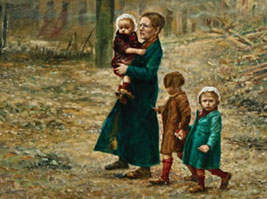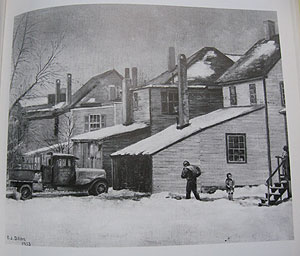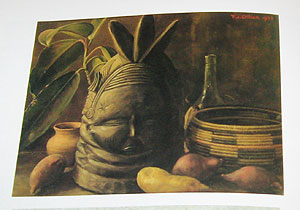I was going through a list of artworks up for previewing at one of my favorite auction houses recently when I came across the name Frank J. Dillon. I was told that he was an African American artist who had lived in Jersey.
I had never heard of Dillon, but I’m always on the lookout for such artists. The auction sheet identified two pieces:
Watercolor, Sleeping Cat, Unsigned [Frank Dillon]. Watercolor over graphite, sleeping cat. 8″ x 10″ = sheet (sight); 14 1/2″ x 17″ = frame.
Oil on Board F[rank] J[oseph] Dillon, 1941. signed & dated, oil on board, war torn. 15 1/2″ x 23 1/2″ image; 18″ x 26 1/4″ = frame.

So, I searched the walls of the auction house for the two works. I saw the cat but it didn’t interest me. I almost passed right by the second piece because it was not what I expected. Most of the art I see by black artists are figurative (even though there are many black artists who paint abstracts), with subject matters I can relate to and people who look like me.
This painting was of a mother and her three children walking through a desolate landscape, and all three were white. It felt more 1890s than 1940s, although Dillon painted the oil on canvas in 1941. I’d love to know where he got his inspiration for it. (Since it was painted during World War II, maybe it’s his depiction of how war had affected one family. The background in the painting indicated the fallows of war. Click on photo to see a wider view.)
I suppose that I should not be so quick to make assumptions about what constitutes African American art. The artists could be black, but their subjects should be anything that inspires or strikes them. Art is about freedom, and I’m sure that’s what Dillon was feeling in choosing to paint this family.
It’s hard to decipher an artist and his muse when you can’t find out much about him or her. That was the case with Dillon. When I Googled his name, I found some references to him but very little background. I found a little more about him in the book “Against the Odds: African American Artists and the Harmon Foundation,” a catalog that accompanied an exhibit organized by the Newark (NJ) Museum in 1989. The foundation was a leading patron of African American artists in the 1920s and 1930s and beyond. The artwork below is from “Against the Odds.”

According to the catalog, Dillon was born in Mount Holly, N.J. (references on the web list his birth year as both 1865 and 1866). He attended St. Augustine College in Raleigh, N.C., from 1883-1887 and Oberlin College from 1887-1889. He worked as a draftsman and designer for a rug company in Vineland, N.J., and as a stained glass designer in Philadelphia. He designed the stained glass windows for the chapel at St. Augustine’s.
He later studied at the Art Students League in New York and the Pennsylvania Museum and School of Industrial Art in Philadelphia. He first participated in the Harmon Foundation exhibits in 1929, receiving an honorable mention, and was represented in several others after that. He died in 1954.
I didn’t attend the art auction, so I’m not sure how much his works sold for. On the web, I found the mother painting up for auction a year before at another local auction, and it was expected to be sold for up to $1,800.
Dillon’s artworks in the Harmon catalog were from 1930s and most were still lifes. I was also able to find on the web an untitled still-life watercolor of a bearded iris in a vase. Maybe I’ll come across one of those still lifes one day. The artwork below is from “Against the Odds.”


Frank J Dillon was my Great Grand Father. One Son Frank J Dillon was my grandfather and Frank Dillon the third was my mother’s brother.
Frank Dillon was excellent with oil painting and he was noted for making stain glass windows. My brother and I each have one oil paintings done by our great grand father.